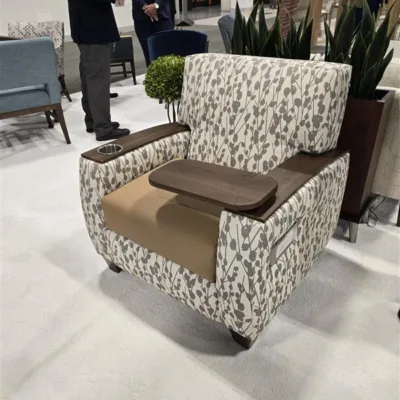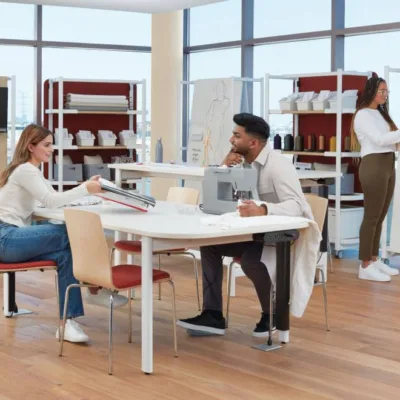We walked away from this year’s Environments for Aging (EFA) Conference with one clear takeaway: the state of senior living is flexible. Not just in furniture or room layouts, but in mindset, approach, and philosophy. Every session, speaker, and hallway conversation pointed to the same truth: if we want to meet the changing needs of residents, care teams, and communities, flexibility can no longer be a nice-to-have. It must be a cornerstone of how we design.
At Living Revolution, we’ve always believed that design isn’t just about creating beautiful spaces—it’s about solving real-world problems through thoughtful, intentional choices. This year’s EFA conversations echoed that belief louder than ever. And as the senior living industry faces demographic shifts, rising care demands, staffing shortages, and tightening budgets, adaptability in design has moved from trend to necessity.
Here’s what we learned—and what it means for the future of senior living.
Design Must Adapt to Evolving Resident Needs
Today’s senior living communities serve a wider range of residents than ever before. Many older adults are entering assisted living later in life, often with complex health needs. At the same time, many are maintaining independence longer and want environments that reflect their lifestyles, not just their limitations.
This means design can’t be one-size-fits-all. We heard from operators who are looking for more fluid room types, flexible care stations, and multi-use community areas that can shift as the population does. Residents want autonomy and dignity, even as they require more care. That calls for spaces that are intuitive, empowering, and adaptable over time.
For example, shared lounges that double as therapy spaces or dining rooms that can easily transform into gathering halls for events are becoming more common. Furniture and fixtures need to serve multiple functions and support diverse needs—from memory care to mobility to social interaction. The goal is to create environments that evolve with the people who live in them.
Staffing Shortages Are Driving New Design Demands
Alongside resident needs, staffing realities are pushing design to do more. Operators are navigating ongoing shortages of qualified caregivers, nurses, and support staff. Design has the power to ease that burden.
One session we attended focused on how spatial layout can reduce steps and streamline workflow. Thoughtfully designed nurse stations, clear sightlines, and easy access to supplies don’t just improve efficiency—they reduce burnout. Environments that support teams by minimizing physical strain and cognitive overload can directly improve retention and care quality.
We also saw a growing interest in technology integration. From circadian lighting that aligns with residents’ natural rhythms to sensor-based alerts that reduce unnecessary check-ins, these tools are becoming part of the design conversation. But the most impactful tech is that which blends into the environment seamlessly without adding complexity for residents or staff.
Innovative Furniture Function and Adaptable Layouts Are Key
We saw creative solutions across the EFA Expo Floor that showcased just how far flexible furnishings have come. For example, Hekman Contract’s multi-purpose lounge seating—used in theater rooms—features tablet arms, casters, and pull handles, making it easy to rearrange and repurpose throughout the community.

Samuelson Living displayed seating with built-in audio capabilities, helping older adults stay engaged with programming and combat isolation—while maintaining flexibility for use in a variety of settings. And several manufacturers, including Global Furniture Group, OFS, and Teknion, introduced movable wall and shelving systems that create spatial divisions without relying on fixed architecture, allowing rooms to transform based on programming needs.
The best part? These aren’t just useful—they’re beautiful. Today’s senior living environments have rejected the institutional feel of the past in favor of warm, inviting, hospitality-driven design. Flexibility no longer means compromising on style. It means creating options that feel welcoming and purposeful. .
At Living Revolution, we work with clients to select furnishings and finishes that serve both function and design. Whether it’s creating movable partitions for a multi-use space or selecting fabrics that balances durability with a residential feel, we help ensure that every element can grow with the community.
Open Visibility and Thoughtful Flow Create Safer, More Connected Spaces
Design that prioritizes openness and visual connection can play a huge role in resident safety and engagement. At EFA, we heard from memory care specialists who emphasized the role of visual cues in reducing agitation and confusion. When residents can easily see where to go—or recognize a dining space or activity room—they feel more secure and confident.
Open visibility also supports staff. When team members can monitor more residents at once without compromising privacy or dignity, it eases their workload and strengthens relationships. It also encourages spontaneous interaction and socialization, which are critical for resident well-being. Open visibility of staff not only helps residents feel more comfortable, but promotes accessibility to staff for families of residents to connect with questions and assistance.

Future-Proofing Requires More Than Just Flexibility—It Requires Intention
The biggest message we heard at EFA wasn’t just about staying flexible, it was about intentionality. Flexibility without strategy creates confusion. But when adaptability is paired with a clear understanding of goals, user needs, and future projections, it becomes a superpower.
This is exactly where Living Revolution thrives.
We go beyond recommending products—we craft design strategies. We look at the lifecycle of the space, the mission of the organization, and the lived experience of residents and staff. From that foundation, we build environments that work today and continue working tomorrow.
Whether that’s recommending design adjustments to manufacturers to accommodate different postures and abilities or sourcing adaptable systems furniture, we’re constantly asking: what’s next, and how can we prepare for it now?
Designing for the Future, Grounded in the Present
As we return from EFA, we’re energized by what lies ahead. ut we’re also grounded in the needs of today. The future of senior living isn’t just about new materials or technologies. It’s about returning to the core purpose of design: to support human life, in all of its complexity.
In senior living, that means creating environments that adapt as people age.That support care teams to avoid burn out.That make residents feel not just cared for, but truly seen.
Flexible design isn’t just the future. It’s a present-day priority. And at Living Revolution, we’re ready to help lead the way.

